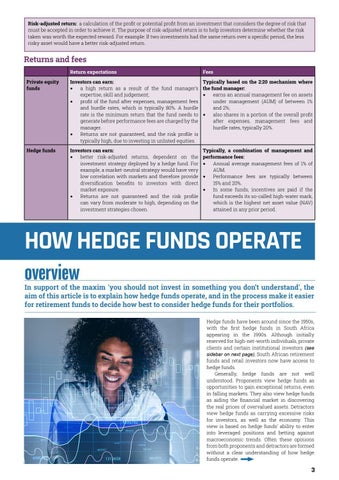Risk-adjusted return: a calculation of the profit or potential profit from an investment that considers the degree of risk that must be accepted in order to achieve it. The purpose of risk-adjusted return is to help investors determine whether the risk taken was worth the expected reward. For example: If two investments had the same return over a specific period, the less risky asset would have a better risk-adjusted return.
Returns and fees Return expectations Private equity funds
Hedge funds
Fees
Investors can earn: Typically based on the 2:20 mechanism where a high return as a result of the fund manager’s the fund manager: • earns an annual management fee on assets expertise, skill and judgement; • profit of the fund after expenses, management fees under management (AUM) of between 1% and hurdle rates, which is typically 80%. A hurdle and 2%; rate is the minimum return that the fund needs to • also shares in a portion of the overall profit after expenses, management fees and generate before performance fees are charged by the hurdle rates, typically 20%. manager. • Returns are not guaranteed, and the risk profile is typically high, due to investing in unlisted equities.
•
Investors can earn: Typically, a combination of management and better risk-adjusted returns, dependent on the performance fees: investment strategy deployed by a hedge fund. For • Annual average management fees of 1% of AUM. example, a market-neutral strategy would have very low correlation with markets and therefore provide • Performance fees are typically between 15% and 20%. diversification benefits to investors with direct • In some funds, incentives are paid if the market exposure. • Returns are not guaranteed and the risk profile fund exceeds its so-called high-water mark, can vary from moderate to high, depending on the which is the highest net asset value (NAV) investment strategies chosen. attained in any prior period.
•
HOW HEDGE FUNDS OPERATE overview
In support of the maxim 'you should not invest in something you don’t understand', the aim of this article is to explain how hedge funds operate, and in the process make it easier for retirement funds to decide how best to consider hedge funds for their portfolios. Hedge funds have been around since the 1950s, with the first hedge funds in South Africa appearing in the 1990s. Although initially reserved for high-net-worth individuals, private clients and certain institutional investors (see sidebar on next page), South African retirement funds and retail investors now have access to hedge funds. Generally, hedge funds are not well understood. Proponents view hedge funds as opportunities to gain exceptional returns, even in falling markets. They also view hedge funds as aiding the financial market in discovering the real prices of overvalued assets. Detractors view hedge funds as carrying excessive risks for investors, as well as the economy. This view is based on hedge funds’ ability to enter into leveraged positions and betting against macroeconomic trends. Often these opinions from both proponents and detractors are formed without a clear understanding of how hedge funds operate.
3






